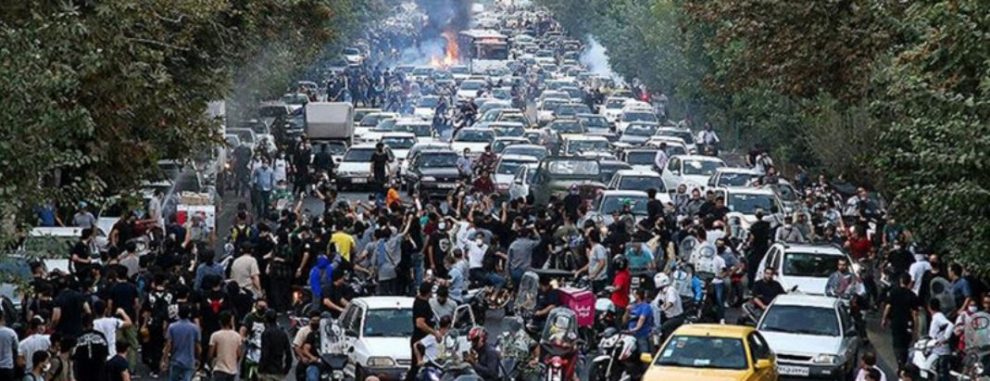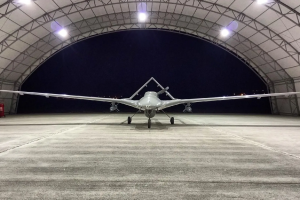by Hakkı Uygur
The death of 22-year-old Mahsa Amini, who was detained in Iran on September 13 and declared dead on September 16, caused widespread protests across the country. While the protesters have been claiming that the young woman died due to ill-treatment in custody, the police and other officials stated that the incident was being investigated, but no ill-treatment had taken place in the detention center, and to support their claims, they published footage of the moments when the young woman died. Ebrahim Raisi personally called the victim’s family and offered his condolences, and Supreme Leader Khamenei’s representative in the Kurdistan province paid a condolence visit to the grieving family. Nevertheless, the sources close to the family and the protesters have continued to insist that the young woman was hit on the head repeatedly in the police car. As a result, the protests have been going on in different cities for about ten days.
The police unit, which is known as Gasht-e Ershad in Persian and can be translated as Morality Police, is actually a relatively new structure that was created during the era of President Khatami and strengthened during the presidency of Ahmadinejad. The philosophy behind the existence of this police unit is based on the principle of “Enjoining good and forbidding evil” in Islamic teachings, and the unit was established in order to prevent chaos concerning this subject by setting a standard and preventing discussions and fights in the streets between different groups. Indeed, the arguments between religious and conservative people and individuals who do not comply with the hijab rules appropriately or smoke on the streets during Ramadan have been causing social problems for a long time.
How did the compulsory hijab come to the agenda?
When we look at the images of the struggle of the 1979 revolution, it is seen that hijabi and non-hijabi women fought together side by side. During the first months of the revolution, it was also possible to see the promises of high-level officials through the newspaper headlines such as “wearing a hijab will not be compulsory.” However, the start of the Iraq War in September 1980 paved the way for strict martial law that was followed by political restrictions in the country. Although these measures were thought to be temporary at the beginning, the implications of some of these measures can be observed even today. In addition to the increasing casualties in the prolonged war, the conflicts created in the streets by volunteer fighters created some tension. Due to the sights they saw when they came to Tehran, these fighters, many of whom came from small provinces and conservative families, complained to the authorities by saying “Is this why we are being martyrs?”. All these developments became effective after a while. As a result, Khomeini issued a fatwa regarding the compulsory hijab for women who work in governmental offices. There are significant anecdotes in the memoirs of former President Hashemi Rafsanjani on the subject.
In the early years of the revolution, Iran had a population of 35 million people, most of whom lived in rural areas and had a low-level education. Contemporary Iran, on the other hand, has reached 85 million people today, whose literacy and higher education rates are at the level of developed countries, and 3/4 of the population lives in cities. So, it significantly differs from former Iran in terms of social and cultural values. The foremost of these differences is undoubtedly the role and position of women. This fact can be easily understood when we look at Iranian society in general and the close circle of the ruling elite. Protesters constantly emphasize on social media that while there are very different images of high-level officials’ children or grandchildren abroad, the young woman died at the detention center after she was detained by the police because of breaking the hijab rules. This contradiction has aroused great resentment throughout the country. The public statements of some deputies and former high-level authorities are a manifestation that the reaction against the incident is shared by a wide range of segments of society. Also, the harsh statements of the famous athletes, actors, and presenters, who are known for their closeness to the administration, were interesting for these cautious groups, who are normally running with the hare and hunting with the hounds. At this point, instead of focusing on large-scale corruption, disasters caused by poor environmental management, or the usurpation of political-cultural freedoms, the meaning of the concepts such as “goodness” and “evil”, that play a very important role in the lives of people and societies, has been reduced to the way of wearing hijab or the discussions regarding if women can go to football matches. It is a significant indicator to show how politicized moral values are becoming shallow.
In what direction will the events evolve?
Iranian society is a very protest community with the effect of historical and cultural reasons, and there is always a gap between the state and the people, so to speak. This is true not only for the ethnic/sectarian groups of the center and the periphery but also for the authorities of the center. Considering the revolution and its aftermath, it would not be wrong to argue that the social faultlines still continue to move. It is seen that the social protests, which took place once every ten years, became more frequent and started to take place every 3-4 years. The most important reason behind this fact is the inadequacy of the “legitimate” channels through which social demands can be expressed. Following the latest example, in a country where there are no political parties, no political formation can make a statement or promise such as “if we come to power, there will be no compulsory hijab, and only those who wish will wear it.” This situation causes many similar social, economic and political demands to be postponed and sharpened, and after a while, they come to the point of explosion for different reasons. The process of electing Ebrahim Raisi as the President with low turnout, as a result of the electoral engineering in the recent period, damaged the balance between the appointed-elected authorities in favor of the appointed ones, although the balance had been tried to be observed since the beginning of the revolution. As a result, it greatly reduced the expectations of large segments of society from legitimate political platforms.
The fact that the young woman who lost her life came to Tehran from the Kurdistan province for a trip caused the demonstrations to take place primarily in the Kurdish-populated provinces. The issue quickly came to the agenda of Kurdish political groups in other countries, for example, Masoud Barzani called the young woman’s family and conveyed his condolences. However, the demonstrations soon spread throughout the country. They have spread to the universities in Tehran and different regions such as Qom, which is considered the religious capital of Iran, or the island of Kish in the Persian Gulf, known as Iran’s Dubai. Also, Turks living in different cities of Iran did not remain silent about the incident. Turkish groups, who normally have a serious disagreement with the Kurds in the country due to some historical and cultural reasons, also participated in the demonstrations in various cities, especially in Tabriz, Ardabil, Zanjan, Qazvin, and Hamedan. Here, it can be argued that such social protests, due to their nature, are rapidly moving away from their starting point and evolving in different directions. For instance, while the “Biji Kurdistan” slogan was shouted in the demonstrations in the province of Kurdistan, where separatist organizations come to the fore, it is possible to come across Turkish slogans referring to recent history such as “Freedom, Justice, National Government” in the demonstrations in Tabriz. Undoubtedly, this is also true for other professional opposition groups, especially the Monarchists and the People’s Mojahedin Organization of Iran.
Although the demonstrations have spread to the whole of Iran and different ethnic and religious groups as of the tenth day of the events, similar experiences in the recent past show us that the Tehran administration can suppress these uprising attempts without difficulty. The number of people who lost their lives in the protests has been much lower compared with the 2018 demonstrations, which shows that the regime does not feel threatened. An important determining factor here is the reaction of international powers and the outsiders within the system to the developments. The symbolic reactions of the international powers reveal that the Western front did not have any expectations from the demonstrations and focused on the Nuclear Deal with Iran, which is on the eve of signing. On the other hand, the Assembly of Experts, which is responsible for electing the next Supreme Leader, met with a great number of absences during the illness and surgery of Ali Khamenei, who had been ruling the country for more than thirty years. Moreover, the Expediency Discernment Council of the System, which was announced by Khamenei after his illness, did not include former President Hassan Rouhani. When these developments are combined with protesters’ slogans against Khamenei’s son, Mojtaba Khamenei, the importance of post-Khamenei scenarios and future projections becomes evident. The demonstrations of millions in 2009 were an intra-state showdown, regarding which the IRGC commanders said that “it was more difficult than the eight-year war in Iraq”. Considering this fact, the attitudes of the moderate-reformist groups, who have been worried about being excluded from the system in the next decades, and especially the attitudes of figures such as Hassan Rouhani, Ali Larijani, and Hassan Khomeini, can be quite decisive for the future of the demonstrations and Iran.
Source: IRAM Center






